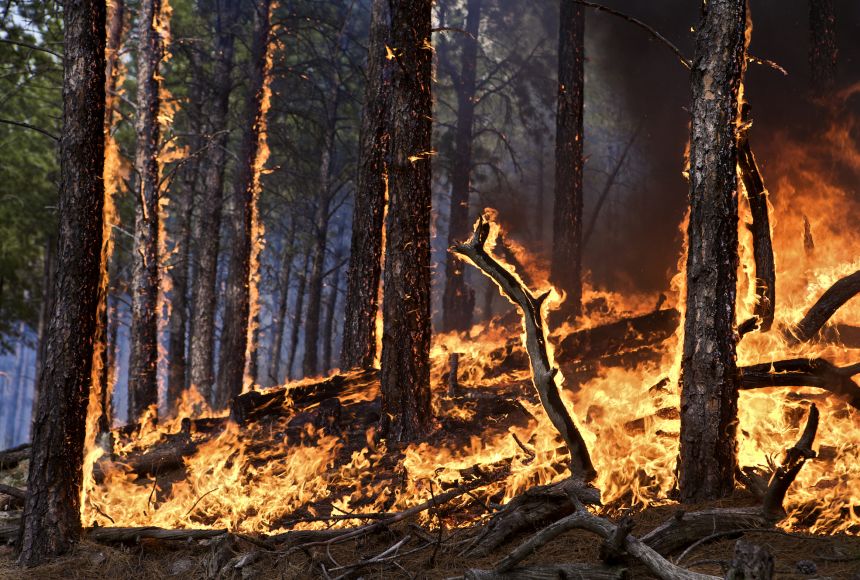As deadly wildfires continue to rage across Northern California’s wine country, with winds picking up speed overnight and worsening conditions to now include a combined 54,000 acres of torched land, it now seems more important than ever to understand how wildfires work, and their lasting implications on our health and the environment.
How a Wildfire Starts
Though the exact source of Sonoma County’s wildfires is unclear, authorities have pointed to the fact that 95 percent of fires in the state of California are started by people, according to CNN.
Meteorologists aren’t yet able to forecast wildfire outbreaks, but there are three conditions that must be present in order for a wildfire to burn. Firefighters refer to it as the fire triangle: fuel, oxygen, and a heat source. Four out of five wildfires are started by people, but dry weather, drought, and strong winds can create a recipe for the perfect disaster—which can transform a spark into a weeks- or months-long blaze that consumes tens of thousands of acres.
Another possible cause of forest fires is lightning. Scientists have found that every degree of global warming sets off a 12 percent bump in lightning activity. Since 1975 the number of fires ignited by lightning has increased between two and five percent.
A Tricky Relationship
Historically, wildfires are actually supposed to be beneficial to certain natural landscapes, clearing underbrush in forests and triggering the release of seeds in some plant species, such as the Jack pine.
Unfortunately, the suppression of naturally occurring, low-intensity forest fires has actually aided in the ability for high-intensity wildfires to run rampant.
In the first half of the 20th century, the U.S. Forest Service suffered from what historian Stephen Pyne calls “pyrophobia,” or the desire to suppress all wildfires (even the good ones). Since the science of forestry first took root in temperate Europe, which is home to a vastly different forest ecosystem than those found in the United States, fire was seen by early U.S. foresters as a problem caused by people.
In some places, the path toward a safer, more ecologically sound relationship with fire is being blazed with prescribed fire, and what’s being called by officials as “managed wildfire.” Fire crews put their efforts to suppress wildfires around the most fire-prone areas, such as communities, municipal watersheds, and sequoia groves. Otherwise they are learning to let some fires burn themselves out, as nature intended.
Wildfires Can Have Long-Lasting Implications for Our Planet
Forest fires actually have the ability to heat up the entire planet, a NASA study from 2016 revealed. In ecosystems such as boreal forests, which store more carbon than any other terrestrial ecosystem on the planet, the effects of climate change are playing out twice as fast.
Fires ravaged the boreal forests of Canada’s vast north woods in May 2016 and continued for months, consuming millions of acres of trees, and scorching the rich organic soil on the forest floor, which serves as a large reservoir for carbon. For every degree that our planet warms, the forest needs a 15 percent increase in precipitation to compensate for increased dryness.
Similar to the case in Northern California, investigators believe that Canada’s boreal forest fire was caused by humans.
Barack Obama visited Alaska in 2015 to highlight the dangers of climate change, calling up images of the hundreds of wildfires that burned across the state just that summer. At the time, 2014 had been the warmest year on record, a milestone that has now been surpassed by 2016.
The Effects of Fire on People
Worldwide, wildfire smoke kills 339,000 people a year, mostly in Asia and sub-Saharan Africa, according to estimates. Tenfold increases in asthma attacks, emergency room visits, and hospital admissions have also been reported when smoke blankets the places where people live.
Common in places such as the western United States, layers of stagnant air called inversions can be created by fires and are responsible for holding smoke down where people breathe. Airborne, microscopic particles that slip past the body’s defenses and into the farthest reaches of the respiratory system can begin to coagulate the blood, forming a thick goo. Smoke also contains carbon monoxide, causing long-lasting damage to the heart.
Emergency room visits for heart failure jumped 37 percent, and saw a 66 percent increase for breathing problem-related visits following the smokiest days of a big 2008 peat fire in eastern North Carolina, EPA researchers found.
How Fire Impacts Wildlife
Wildlife tend to have a very different relationship with fire. Some have evolved to live with it, and some even thrive after fires. That’s not to say all wild animals call fire a friend—there are some who can’t outrun the quickly moving flames, and young or small animals are particularly at risk.
Slow-moving animals such as koalas, whose natural instinct is to crawl up further into a tree, may end up trapped.
For many environments, fire doesn’t actually have to mean death, but instead change, re-birth, or new opportunities. For example, woodpeckers will fly in to feast on bark beetles in dead and dying trees, and leave when the beetles are gone.
A year-old forest will have a different set of flora and fauna inhabiting it than a forest that is 40 years old, and according to wildlife biologist Patricia Kennedy, “a lot of species require that reset,” which comes from a fire.
